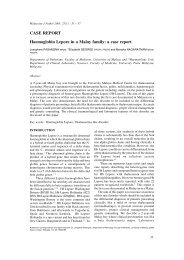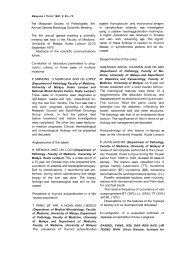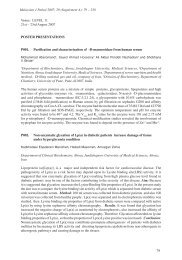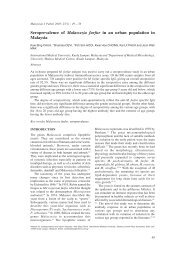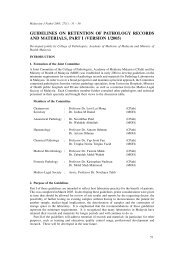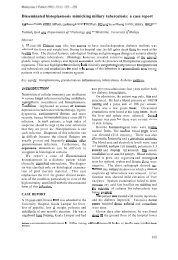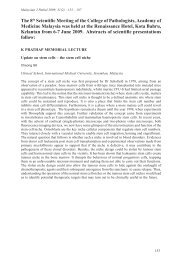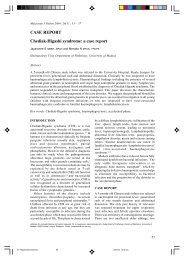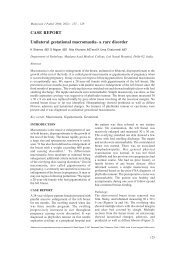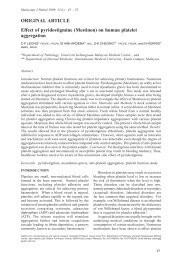CASE REPORT Microfilaria in hydrocele fluid cytology - MJPath
CASE REPORT Microfilaria in hydrocele fluid cytology - MJPath
CASE REPORT Microfilaria in hydrocele fluid cytology - MJPath
You also want an ePaper? Increase the reach of your titles
YUMPU automatically turns print PDFs into web optimized ePapers that Google loves.
Malaysian J Pathol 2004; 26(2) : 119 – 123<br />
MICROFILARIA IN HYDROCELE FLUID CYTOLOGY<br />
<strong>CASE</strong> <strong>REPORT</strong><br />
<strong>Microfilaria</strong> <strong>in</strong> <strong>hydrocele</strong> <strong>fluid</strong> <strong>cytology</strong><br />
Patricia Ann CHANDRAN MD, Gita JAYARAM MIAC, FRCPath, *Rohela MAHMUD MBBS, MPHTM<br />
and *Khairul Anuar A PhD, FACTM<br />
Departments of Pathology and *Parasitology, Faculty of Medic<strong>in</strong>e, University of Malaya<br />
Abstract<br />
Filariasis, a parasitic <strong>in</strong>fection endemic <strong>in</strong> parts of India, Myanmar, islands of the South Pacific, West<br />
and East Africa and Saudi Arabia can be diagnosed from various types of cytopathological<br />
specimens. This case documents the detection of filarial <strong>in</strong>fection from <strong>hydrocele</strong> <strong>fluid</strong> <strong>cytology</strong> <strong>in</strong><br />
a 30-year-old Myanmar migrant worker <strong>in</strong> Malaysia.<br />
Keywords: Cytology, <strong>hydrocele</strong>. chylous, microfilaria, Wuchereria bancrofti<br />
INTRODUCTION<br />
<strong>Microfilaria</strong>e have been demonstrated <strong>in</strong><br />
cytological preparations made from various sites<br />
<strong>in</strong>clud<strong>in</strong>g cervico-vag<strong>in</strong>al smears, pericardial<br />
<strong>fluid</strong>, <strong>hydrocele</strong> <strong>fluid</strong>, nipple secretions, bone<br />
marrow smears and f<strong>in</strong>e needle aspiration<br />
cytological smears from varied sites <strong>in</strong>clud<strong>in</strong>g<br />
breast, thyroid, lymph node, salivary gland, liver<br />
and epididymis. 1-7 This paper reports the f<strong>in</strong>d<strong>in</strong>g<br />
of microfilaria of Wuchereria bancrofti(Wb)<br />
species <strong>in</strong> cytological smears from a chylous<br />
<strong>hydrocele</strong> <strong>in</strong> a 30-year-old male migrant worker.<br />
<strong>CASE</strong> <strong>REPORT</strong><br />
A 30-year-old Myanmar national who had been<br />
work<strong>in</strong>g <strong>in</strong> Malaysia for the past three years<br />
presented to the Urology cl<strong>in</strong>ic of the University<br />
Malaya Medical Centre, Kuala Lumpur with<br />
compla<strong>in</strong>ts of a left scrotal swell<strong>in</strong>g for the past<br />
one year. He gave a history of a surgical procedure<br />
done for a similar compla<strong>in</strong>t <strong>in</strong> Myanmar two<br />
years ago but had no records. On cl<strong>in</strong>ical<br />
exam<strong>in</strong>ation, the patient was found to have a left<br />
sided <strong>hydrocele</strong> with no regional<br />
lymphadenopathy, fever, sk<strong>in</strong> rashes or<br />
lymphoedema. A Jabouley’s operation 8 was<br />
carried out. Dur<strong>in</strong>g the procedure, the spermatic<br />
cord was noted to be thickened, <strong>in</strong>flamed and<br />
<strong>in</strong>filtrated with adipose tissue. The testicular sac<br />
was also thickened. The <strong>hydrocele</strong> <strong>fluid</strong> was sent<br />
for cytological study and part of the tunica<br />
vag<strong>in</strong>alis was excised for histological<br />
exam<strong>in</strong>ation. No haematological <strong>in</strong>vestigations<br />
were done at that time. The patient was given an<br />
appo<strong>in</strong>tment for follow-up six weeks follow<strong>in</strong>g<br />
the surgical procedure and was discharged. He<br />
however defaulted and was lost to follow-up.<br />
Pathology<br />
The <strong>hydrocele</strong> <strong>fluid</strong> received <strong>in</strong> the <strong>cytology</strong> lab,<br />
(10 ml of chylous <strong>fluid</strong>), was centrifuged and the<br />
deposit smeared onto clean glass slides. Smears<br />
were air-dried, fixed <strong>in</strong> methanol and sta<strong>in</strong>ed<br />
with the May-Grunwald-Giemsa (MGG) sta<strong>in</strong>.<br />
Two smears were wet-fixed <strong>in</strong> 95% ethanol and<br />
sta<strong>in</strong>ed with the Papanicolaou (Pap) technique.<br />
After cytological study revealed microfilaria,<br />
the rema<strong>in</strong><strong>in</strong>g <strong>fluid</strong> was sent to the Department<br />
of Parasitology where additional smears were<br />
prepared and sta<strong>in</strong>ed with the Giemsa technique<br />
for better visualization of the nuclei. The patient<br />
was later recalled to the cl<strong>in</strong>ic where the diagnosis<br />
was confirmed on immunochromatographic<br />
(ICT) test<strong>in</strong>g, thick blood smear and Knott’s<br />
concentration technique. Blood for thick blood<br />
smears was taken <strong>in</strong> the daytime as the patient<br />
was not agreeable to make a nocturnal trip to the<br />
hospital.<br />
Cytological, parasitology, serological and<br />
histological features<br />
Smears of the <strong>hydrocele</strong> <strong>fluid</strong> sta<strong>in</strong>ed with MGG,<br />
Pap sta<strong>in</strong> and Giemsa showed sheathed<br />
microfilariae that had discrete nuclei throughout<br />
the body with an empty caudal space devoid of<br />
nuclei (Figures 1 & 2). Foamy histiocytes were<br />
seen aggregated around the cephalic end of some<br />
of the microfilariae (Figure 3). The thick blood<br />
smear showed microfilaria (Figure 4), albeit <strong>in</strong><br />
Address for correspondence and repr<strong>in</strong>t requests: Dr. Patricia Ann Chandran, Department of Pathology, Faculty of Medic<strong>in</strong>e, University of Malaya, 50603<br />
Kuala Lumpur, Malaysia.<br />
119
Malaysian J Pathol December 2004<br />
FIG. 1: <strong>Microfilaria</strong> <strong>in</strong> cytological smear of <strong>hydrocele</strong> <strong>fluid</strong> (note empty caudal space devoid of nuclei).<br />
Giemsa x 120<br />
FIG. 2: Caudal space of microfilaria devoid of nuclei. Giemsa x 300<br />
120
MICROFILARIA IN HYDROCELE FLUID CYTOLOGY<br />
FIG. 3: Foamy histiocytes aggregat<strong>in</strong>g around the cephalic end of the microfilaria.<br />
Giemsa x 60<br />
FIG. 4: <strong>Microfilaria</strong> <strong>in</strong> thick blood smear. Giemsa x 120<br />
121
Malaysian J Pathol December 2004<br />
scant numbers. Knott’s concentration technique<br />
was also positive. The ICT test on serum of the<br />
patient detected the presence of antigens for Wb.<br />
Histological sections of the tunica vag<strong>in</strong>alis<br />
showed fibrovascular tissue with no microfilaria<br />
identified.<br />
DISCUSSION<br />
Filariasis is endemic <strong>in</strong> Asia and an estimated<br />
100 million people throughout the tropics and<br />
subtropics are thought to be <strong>in</strong>fected by<br />
bancroftian filariasis. 9 About 40 million people<br />
<strong>in</strong> endemic regions suffer from chronic<br />
disfigur<strong>in</strong>g lymphatic filariasis, <strong>in</strong>clud<strong>in</strong>g 27<br />
million men with testicular <strong>hydrocele</strong>, lymph<br />
scrotum or elephantiasis of the scrotum. 10 Acute<br />
lymphangitis of the spermatic cord (funiculitis),<br />
epididymitis, orchitis, scrotal oedema and<br />
<strong>hydrocele</strong> are common manifestations of<br />
bancroftian filariasis.<br />
Bancroftian filariasis is caused by the<br />
nematode Wuchereria bancrofti. Liv<strong>in</strong>g and<br />
dead adult worms cause symptoms. Adult worms<br />
live <strong>in</strong> the lymph channels near the major lymph<br />
glands of the lower half of the body and cause<br />
dilatation of the channels, <strong>in</strong>terfer<strong>in</strong>g with lymph<br />
flow and result<strong>in</strong>g <strong>in</strong> lymphoedema and leakage<br />
of lymph <strong>in</strong>to the tissues. 11 The obstructive phase<br />
is marked with lymph varices, lymph scrotum,<br />
<strong>hydrocele</strong>, chyluria and elephantiasis with hard,<br />
non-pitt<strong>in</strong>g edema and thickened, verrucous sk<strong>in</strong>.<br />
<strong>Microfilaria</strong>e are not present <strong>in</strong> these lesions and<br />
do not per se cause lymph obstruction. The<br />
pathogenesis of lymphatic filariasis is based on<br />
<strong>in</strong>flammatory and immune responses of the host<br />
and varies from nongranulomatous chronic<br />
lymphatic <strong>in</strong>flammation to granulomatous<br />
obstructive reactions. 11 The cause of lymphatic<br />
dilatation with Wb is not known although<br />
lymphatic dilatation was a universal<br />
ultrasonographic f<strong>in</strong>d<strong>in</strong>g among adult worm<br />
carriers and those with microfilaremia.<br />
Ultrasound has now been used <strong>in</strong> lymphatic<br />
filariasis to exam<strong>in</strong>e men with asymptomatic<br />
adult Wb <strong>in</strong>fections who do not respond to<br />
treatment with antifilarial medication and to<br />
establish the relationship between lymphatic<br />
dilatation and the development of scrotal<br />
morbidity. 12<br />
A diagnosis of filariasis is considered when a<br />
history of exposure to mosquitoes <strong>in</strong> an endemic<br />
area is re<strong>in</strong>forced with relevant cl<strong>in</strong>ical f<strong>in</strong>d<strong>in</strong>gs<br />
and is cl<strong>in</strong>ched by the demonstration of<br />
microfilariae <strong>in</strong> a thick blood smear obta<strong>in</strong>ed at<br />
night. In Malaysia, the sub-periodic form of<br />
Brugia malayi (Bm) occurs <strong>in</strong> swamp forests<br />
while the periodic form is endemic <strong>in</strong> the coastal<br />
rice field regions of the country. Although Wb<br />
has been eradicated, especially from the cities,<br />
the vector (Culex qu<strong>in</strong>quefasciatus) still breeds<br />
<strong>in</strong> abundance. 13-16 In the present case, the<br />
microfilariae were identified <strong>in</strong> cytological<br />
smears of <strong>hydrocele</strong> <strong>fluid</strong> and characterized as<br />
Wb based on presence of a sheath, dist<strong>in</strong>ct nuclear<br />
bodies that did not reach the caudal end with a<br />
cephalic space free of nuclei and positivity for<br />
the ICT test. The microfilarial nuclei were<br />
visualized better with the Giemsa sta<strong>in</strong> done on<br />
the thick blood smear (Figure 4). Serological<br />
test<strong>in</strong>g for antibodies to filarial antigen may be<br />
of diagnostic value when microfilariae cannot<br />
be found <strong>in</strong> the blood. Two tests are commercially<br />
available, the enzyme-l<strong>in</strong>ked immunosorbent<br />
assay (ELISA) and the other is the rapid-format<br />
ICT test that detects the circulat<strong>in</strong>g antigens of<br />
Wb. 17 The first commercially available antigen<br />
detection assay for bancroftian filariasis, a<br />
monoclonal antibody-based sandwich ELISA<br />
that uses the IgM antibody known as Og4C3,<br />
has a reported sensitivity that ranges from 73%<br />
to 100% and it is useful for field <strong>in</strong>vestigations<br />
and epidemiological assessments. 18 Polymerase<br />
cha<strong>in</strong> reaction-based assays for DNA of Wb<br />
have greater diagnostic sensitivity but are<br />
expensive and time consum<strong>in</strong>g procedures not<br />
suitable for rout<strong>in</strong>e diagnostic purposes. The<br />
standard antiparasitic treatment for lymph<br />
filariasis caused by Wb and Bm is<br />
Diethylcarbamaz<strong>in</strong>e (DEC). Ivermect<strong>in</strong>, a<br />
macrolide antibiotic, may be particularly useful<br />
for the control of lymph filariasis <strong>in</strong> areas where<br />
loiasis or onchocerciasis co-exist and where<br />
treatment with DEC is therefore<br />
contra<strong>in</strong>dicated. 19 Regimens that utilize s<strong>in</strong>gledose<br />
DEC or Ivermect<strong>in</strong> or comb<strong>in</strong>ations of<br />
s<strong>in</strong>gle doses of Albendazole and either DEC or<br />
Ivermect<strong>in</strong> have all been demonstrated to have a<br />
susta<strong>in</strong>ed microfilaricidal effect. 17 Reports of<br />
“resistant” filarial parasites have started to<br />
appear. 20<br />
We believe this to be the first documented<br />
case <strong>in</strong> Malaysia of diagnosis of filariasis by<br />
<strong>hydrocele</strong> <strong>fluid</strong> <strong>cytology</strong>. In a recent study done<br />
on 809 migrant workers <strong>in</strong> Malaysia <strong>in</strong> which 52<br />
cases were screened for bancroftian filariasis,<br />
only one sample, obta<strong>in</strong>ed from a Myanmar<br />
worker, was positive. 21 We would also like to<br />
stress the importance of possible changes <strong>in</strong> the<br />
facet of lymphatic filariasis <strong>in</strong> Malaysia due to<br />
the <strong>in</strong>flux of foreign workers and immigrants<br />
from neighbour<strong>in</strong>g countries like Indonesia,<br />
Philipp<strong>in</strong>es, Myanmar, India, Bangladesh and<br />
122
MICROFILARIA IN HYDROCELE FLUID CYTOLOGY<br />
Pakistan. Default<strong>in</strong>g treatment, particularly<br />
common <strong>in</strong> migrant workers, cont<strong>in</strong>ues to pose<br />
a problem <strong>in</strong> eradicat<strong>in</strong>g <strong>in</strong>fections <strong>in</strong> this<br />
country.<br />
REFERENCES<br />
1. Varghese R, Raghuveer CV, Pai MR, Bansal R.<br />
<strong>Microfilaria</strong>e <strong>in</strong> cytologic smears: a report of six<br />
cases. Acta Cytol 1996; 40:299-301.<br />
2. Vassilakos P, Cox JN. Filariasis diagnosed by cytological<br />
exam<strong>in</strong>ation of <strong>hydrocele</strong> <strong>fluid</strong>. Acta Cytol<br />
1974; 18:62-4.<br />
3. Mehrotra R, S<strong>in</strong>gh M, Javed K, Gupta RK. Cytodiagnosis<br />
of microfilaria of the breast from a needle<br />
aspirate. Acta Cytol 1999; 43: 517-8.<br />
4. Sodhani P, Nayar M. <strong>Microfilaria</strong>e <strong>in</strong> a thyroid<br />
aspirate smears: an <strong>in</strong>cidental f<strong>in</strong>d<strong>in</strong>g. Acta Cytol<br />
1989; 33: 942-3.<br />
5. Dey P, Radhika S, Ja<strong>in</strong> A. <strong>Microfilaria</strong>e of Wuchereria<br />
bancrofti <strong>in</strong> a lymph node aspirate. A case<br />
report. Acta Cytol 1993; 37: 745-6.<br />
6. Jayaram G. <strong>Microfilaria</strong>e <strong>in</strong> f<strong>in</strong>e needle aspirates<br />
form epididymal lesions. Acta Cytol 1987; 31: 59-<br />
62.<br />
7. Agarwal R, Khanna D, Barthwal SP. <strong>Microfilaria</strong>e<br />
<strong>in</strong> a cytologic smear from cavernous haemgioma of<br />
the liver. Acta Cytol 1998; 42:781-2.<br />
8. Russell RCG, Williams NS, Bulstrode CJK, editors.<br />
Bailey & Love’short practice of surgery. 23 rd<br />
edition. London, Arnold; 2000.<br />
9. Michael E, Bundy DA, Grenfell BT. Re-assess<strong>in</strong>g<br />
the global prevalence and distribution of lymphatic<br />
filariasis. Parasitology 1996; 112: 409-28.<br />
10. Schmidt GD, Roberts LS, editors. Foundations of<br />
Parasitology. 6 th edition. Boston: Mac-Graw Hill;<br />
2000.<br />
11. Neva FA and Brown HW, editors. Basic Cl<strong>in</strong>ical<br />
Parasitology. 6 th edition. Norwalk (Connecticut):<br />
Appleton & Lange; 1994.<br />
12. Noroes J, Addiss D, Santos A, Mereidos Z, Cout<strong>in</strong>ho<br />
A, Dreyer G. Ultrasonographic evidence of abnormal<br />
lymphatic vessels <strong>in</strong> young men with adult<br />
Wuchereria bancrofti <strong>in</strong>fection <strong>in</strong> the scrotal area.<br />
J Urol 1996; 156: 409-12.<br />
13. Mak JW. Filariasis. Bullet<strong>in</strong> Institute Medical Research.<br />
1985; 35: 5-8.<br />
14. Mak JW, Yen PKF, Lim PKC, Ramiah N. Zoonotic<br />
implications of cats and dogs <strong>in</strong> filarial transmission<br />
<strong>in</strong> Pen<strong>in</strong>sular Malaysia. Trop Geog Med 1980;<br />
32: 259-64.<br />
15. Yap HH, Jahangir C, Chong AS, Adanan CR,<br />
Chong NL, Malik YA, Rohaizat B. Field efficacy<br />
of a new repellent, KBR 3023, aga<strong>in</strong>st Aedes<br />
albopictus (SKUSE) and Culex qu<strong>in</strong>quefasciatus<br />
(SAY) <strong>in</strong> a tropical environment. J Vector Ecol<br />
1998; 23: 62-8.<br />
16. Lee HL, Tadano T. Monitor<strong>in</strong>g resistance gene<br />
frequencies <strong>in</strong> Malaysian Culex qu<strong>in</strong>quefasciatus<br />
(SAY) adults us<strong>in</strong>g rapid non-specific esterase enzyme<br />
microassays. Southeast Asian J Trop Med<br />
Pub Health 1994; 25: 371-3.<br />
17. Braunwald E, Fauci AS, Kasper DL, Hauser SL,<br />
Longo DL, Jameson JL, editors. Harrison’s Pr<strong>in</strong>ciples<br />
of Internal Medic<strong>in</strong>e. 15 th edition. New York:<br />
Mac-Graw Hill; 2001.<br />
18. Rocha A, Addiss D, Ribeiro ME, et al. Evaluation<br />
of the Og4C3 ELISA <strong>in</strong> Wuchereria bancrofti <strong>in</strong>fection:<br />
<strong>in</strong>fected persons with undetectable or ultralow<br />
microfilarial densities. Trop Med Int Health<br />
1996; 1: 859-64.<br />
19. Ottesen EA. Efficacy of diethylcarbamaz<strong>in</strong>e <strong>in</strong> eradicat<strong>in</strong>g<br />
<strong>in</strong>fection with lymphatic-dwell<strong>in</strong>g filariae <strong>in</strong><br />
hymans. Rev Infect Dis 1985; 7: 341-56.<br />
20. Awadzi K, Boakye DA, Edwards G, et al. An<br />
<strong>in</strong>vestigation of persistent microfilariademias despite<br />
multiple treatment with ivermect<strong>in</strong> to onchocerciasis<br />
endemic foci <strong>in</strong> Ghana. Ann Trop Med<br />
Parasitol 1998; 231-49.<br />
21. Zura<strong>in</strong>ee MN. Parasitic <strong>in</strong>fection among foreign<br />
workers: serological f<strong>in</strong>d<strong>in</strong>gs. JUMMEC 2002; 7:<br />
70-6.<br />
123




